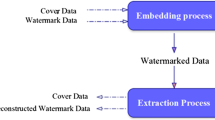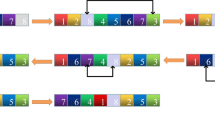Abstract
This paper presents a robust image watermarking method based on geometric modeling. Four samples of wavelet approximation transform on each image block along with the mean value of other coefficients on that block are modeled as three points in 2-D space. The length and width coordinate of the point associated with the mean value are equal. Two line segments with a shared endpoint can be drawn using these three points. The vertex angle formed between the line segments is utilized as a watermarking variable. In order to embed message bits, the vertex angle is altered by displacing of points. To preserve the imperceptibility of the watermark, geometrical tools are elegantly used to minimize the embedding distortion. Moreover, Maximum likelihood decoder is implemented at the receiver side. To this end, the probability density function of the noisy embedded angles is well approximated by the Beta distribution for wavelet approximation coefficients of images. Due to embedding in the vertex angle, the proposed scheme is not vulnerable to the gain attack. Using the low frequency components of the image blocks and the mean value of each block makes the proposed method robust to the noise and compression attacks. Experimental results confirm the validity of the theoretical analyses given in the paper and show the superiority of the method in contrast to similar techniques in this field.










Similar content being viewed by others
References
Akhaee M, Amini A, Ghorbani G, Marvasti F (2010) A solution to gain attack onwatermarking systems: logarithmic homogeneous rational dither modulation. In: 2010 IEEE international conference on acoustics speech and signal processing (ICASSP), pp 1746–1749. doi:10.1109/ICASSP.2010.5495452
Akhaee M, Sahraeian S, Jin C (2011) Blind image watermarking using a sample projection approach. IEEE Trans Inf Forensic Secur 6(3):883–893. doi:10.1109/TIFS.2011.2146250
Akhaee M, Sahraeian S, Sankur B, Marvasti F (2009) Robust scaling-based image watermarking using maximum-likelihood decoder with optimum strength factor. IEEE Trans Multimedia 11(5):822–833. doi:10.1109/TMM.2009.2012922
Akhaee MA, Kalantari NK, Marvasti F (2010) Robust audio and speech watermarking using gaussian and laplacian modeling. IEEE Trans Sig Process 90(8):2487–2497. doi:10.1016/j.sigpro.2010.02.013
Balado F (2005) New geometric analysis of spread-spectrum data hiding with repetition coding, with implications for side-informed schemes. In: Proceedings IWDW, vol 4675. Siena, Italy, pp 336–350
Chen B, Wornell G (2001) Quantization index modulation: a class of provably good methods for digital watermarking and information embedding. IEEE Trans Inf Theory 47(4):1423–1443. doi:10.1109/18.923725
Conway JH, Sloane NJA, Bannai E (1998) Sphere-packings, lattices, and groups. Springer-Verlag, New York
Costa M (1983) Writing on dirty paper (corresp.) IEEE Trans Inf Theory 29(3):439–441. doi:10.1109/TIT.1983.1056659
Cox I, Kilian J, Leighton F, Shamoon T (1997) Secure spread spectrum watermarking for multimedia. IEEE Trans Image Process 6(12):1673–1687. doi:10.1109/83.650120
Eggers J, Buml R, Girod B (2002) Estimation of amplitude modifications before scs watermark detection. In: Proceedings SPIE: security watermarking multimedia contents IV, vol 4675, pp 387–398
Guccione P, Scagliola M (2009) Hyperbolic rdm for nonlinear valumetric distortions. IEEE Trans Inf Forensic Secur 4(1):25–35. doi:10.1109/TIFS.2008.2011080
Kalantari N, Ahadi S (2010) A logarithmic quantization index modulation for perceptually better data hiding. IEEE Trans Image Process 19(6):1504–1517. doi:10.1109/TIP.2010.2042646
Lee K, Kim D, Kim T, Moon K (2003) Em estimation of scale factor for quantization-based audio watermarking. In: Proceedings of the 2nd international workshop digital watermarking, Seoul, pp 316–327
Li Q, Cox I (2007) Using perceptual models to improve fidelity and provide resistance to valumetric scaling for quantization index modulation watermarking. IEEE Trans Inf Forensics Secur 2(2):127–139. doi:10.1109/TIFS.2007.897266
Marsaglia G, Tsang W, Wang J (2003) Evaluating kolmogorov’s distribution. J Stat Softw 8(18):1–4
Massey FJ (1951) The kolmogorov-smirnov test for goodness of fit. J Am Stat Assoc 46(253):68–78
Miller M, Doerr G, Cox I (2004) Applying informed coding and embedding to design a robust highcapacity watermark. IEEE Trans Image Process 13(6):792–807. doi:10.1109/TIP.2003.821551
Nezhadarya E, Wang ZJ, Ward RK (2011) Robust image watermarking based on multiscale gradient direction quantization. 6(4):1200–1213
Oostveen JC, Kalker T, Staring M (2004) Adaptive quantization watermarking. In: Proceedings of the SPIE security watermarking multimedia contents, vol 5306. San Jose, pp 296–303
Ourique F, Licks V, Jordan R, Perez-Gonzalez F (2005) Angle qim: a novel watermark embedding scheme robust against amplitude scaling distortions. In: Proceedings of the IEEE international conference on acoustics, speech, and signal processing 2005 (ICASSP ’05), vol 2, pp 797–800. doi:10.1109/ICASSP.2005.1415525
Pearson K (1895) Mathematical contribution to the theory of evolution. ii. skew variation in homogeneous material. Philos Trans R Soc Lond 186:343–414. doi:10.1109/TIP.2003.819861
Perez-Gonzalez F, Mosquera C (2008) Quantization-based data hiding robust to linear-time-invariant filtering. IEEE Trans Inf Forensic Secur 3:137–152. doi:10.1109/TIFS.2008.922057
Perez-Gonzalez F, Mosquera C, Barni M, Abrardo A (2005) Rational dither modulation: a highrate data-hiding method invariant to gain attacks. IEEE Trans Sig Process 53(10):3960–3975. doi:10.1109/TSP.2005.855407
Phadikara A, Maity SP, Verma B (2011) Region based qim digital watermarking scheme for image database in dct domain. Comput Electr Eng 37(3):339–355
Shterev I, Lagendijk R (2006) Amplitude scale estimation for quantization-based watermarking. IEEE Trans Sig Process 54(11):4146–4155. doi:10.1109/TSP.2006.881216
Valizadeh A, Wang Z (2012) An improved multiplicative spread spectrum embedding scheme for data hiding. IEEE Trans Inf Forensic Secur 7(4):1127–1143. doi:10.1109/TIFS.2012.2199312
Wang Y, Doherty J, Van Dyck R (2002) A wavelet-based watermarking algorithm for ownership verification of digital images. IEEE Trans Image Process 11(2):77–88. doi:10.1109/83.982816
Wang Z, Bovik A, Sheikh H, Simoncelli E (2004) Image quality assessment: from error visibility to structural similarity. IEEE Trans Image Process 13(4):600–612. doi:10.1109/TIP.2003.819861
Wu M, Liu B (2003) Data hiding in image and video. i. fundamental issues and solutions. IEEE Trans Image Process 12(6):685–695
Author information
Authors and Affiliations
Corresponding author
Appendix
Appendix
Deriving the parameters of the approximated Beta distribution on the specific interval
The Beta probability density function has a variety of shapes; hence this distribution is widely used to model various types of random variables that take values in bounded intervals. The first two moments of the Beta distribution with the shape parameters α and β on the interval [a, c] are:
The method of moments (MoM), first discussed in Pearson [21], matches the equations for the mean and central moments, as needed, of a fitted distribution to the mean and central moments of the data set.
Suppose now that x = (x 1, x 2, . . . , x n ) is a random sample of size n from the Beta distribution with unknown parameter α and β. Also, let μ and σ 2 be the sample mean and variance estimate as:
Substituting the sample mean and variance in (29) and rearranging, we get:
where \(\hat \alpha \) and \(\hat \beta \) are the estimated parameters. Here, the MoM approach is used to estimate the shape parameters of the noisy watermarked vertex angle.
Rights and permissions
About this article
Cite this article
Hamghalam, M., Mirzakuchaki, S. & Ali Akhaee, M. Vertex angle image watermarking with optimal detector. Multimed Tools Appl 74, 3077–3098 (2015). https://doi.org/10.1007/s11042-013-1769-1
Published:
Issue Date:
DOI: https://doi.org/10.1007/s11042-013-1769-1




